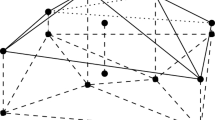Abstract
Given a data set in the multivariate Euclidean space, we study regions of central points built by averaging all their subsets with a fixed number of elements. The averaging of these sets is performed by appropriately scaling the Minkowski or elementwise summation of their convex hulls. The volume of such central regions is proposed as a multivariate scatter estimate and a circular sequence algorithm to compute the central regions of a bivariate data set is described.
Similar content being viewed by others
References
Artzner Ph, Delbaen F, Eber JM and Heath D (1999). Coherent measures of risk. Math Financ 9: 203–228
Bickel PJ and Lehmann EL (1975). Descriptive statistics for nonparametric models. II. Location. Ann Statist 3: 1045–1069
Bickel PJ and Lehmann EL (1976). Descriptive statistics for nonparametric models. III. Dispersion. Ann Statist 4: 1139–1158
Cascos I (2006). Expected convex hull trimming of a data set. In: Rizzi, A and Vichi, M (eds) COMPSTAT 2006. Proceedings in computational statistics, pp 673–680. Physica-Verlag, Heidelberg
Cascos I (2007) Depth functions based on a number of observations of a random vector. Working paper 07-29. Statistics and Econometrics Series, Universidad Carlos III de Madrid. Available from http://econpapers.repec.org/paper/ctewsrepe/
Cascos I and López-Díaz M (2005). Integral trimmed regions. J Multivar Anal 96: 404–424
Cascos I and Molchanov I (2007). Multivariate risks and depth-trimmed regions. Financ Stoch 11: 373–397
Dyckerhoff R (2000). Computing zonoid trimmed regions of bivariate data sets. In: Bethlehem, J and Heijden, P (eds) COMPSTAT 2000. Proceedings in computational statistics, pp 295–300. Physica-Verlag, Heidelberg
van der Edelsbrunner H (1987). Algorithms in combinatorial geometry. Springer, Berlin
Jouini E, Meddeb M and Touzi N (2004). Vector-valued coherent risk measures. Financ Stoch 8: 531–552
Koshevoy G and Mosler K (1997). Zonoid trimming for multivariate distributions. Ann Statist 25: 1998–2017
Liu RY (1990). On a notion of data depth based on random simplices. Ann Statist 18: 405–414
Liu RY, Parelius JM and Singh K (1999). Multivariate analysis by data depth: descriptive statistics, graphics and inference. Ann Statist 27: 783–858
Massé JC and Theodorescu R (1994). Halfplane trimming for bivariate distributions. J Multivar Anal 48: 188–202
Molchanov I (2005). Theory of Random Sets. Springer, London
Mosler K (2002). Multivariate dispersion, central regions and depth. The lift zonoid approach. Lecture Notes in Statistics, vol 165. Springer, Berlin
Oja H (1983). Descriptive statistics for multivariate distributions. Statist Probab Lett 1: 327–332
Ruts I and Rousseeuw PJ (1996). Computing depth contours of bivariate point clouds. Comput Statist Data Anal 23: 153–168
Tukey JW (1975) Mathematics and the picturing of data. In: Proceedings of the International Congress of Mathematicians. Vancouver, pp 523–531
Zuo Y and Serfling R (2000a). General notions of statistical depth function. Ann Statist 28: 461–482
Zuo Y and Serfling R (2000b). Structural properties and convergence results for contours of sample statistical depth functions. Ann Statist 28: 483–499
Zuo Y and Serfling R (2000c). Nonparametric notions of multivariate “scatter measure” and “more scattered” based on statistical depth functions. J Multivar Anal 75: 62–78
Author information
Authors and Affiliations
Corresponding author
Additional information
Supported by the Spanish Ministry of Education and Science under grant MTM2005-02254.
Rights and permissions
About this article
Cite this article
Cascos, I. The expected convex hull trimmed regions of a sample. Computational Statistics 22, 557–569 (2007). https://doi.org/10.1007/s00180-007-0095-3
Received:
Accepted:
Published:
Issue Date:
DOI: https://doi.org/10.1007/s00180-007-0095-3




